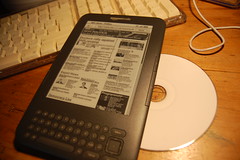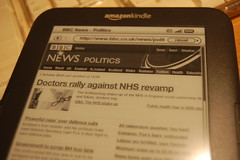I finally got my Amazon Kindle today – here are my first impressions. It’s my first electronic book-reader – partly because it’s the first one to come up to snuff, but I also bought it because I was intrigued with the technology, the free 3G connection – and the low price tag. At that price, it would have been rude not to…
Display
The display is just stunning. I have to confess that when I got it out of the box, I tried to peel what I thought was a printed instruction label off the front of the unit. It wasn’t a printed label – it was the display actually working. The electronic ink technology really is fantastic.
It was much smaller than I expected, but that’s no bad thing… the size of paperback, only thinner. Crucially, it fits in my inside jacket pocket.
I bought it via my Amazon account, so it came pre-registered and knew who I was – which was nice. I have the 3G version which downloaded a few free books (Sherlock Holmes, natch) pretty quickly – though the choice of free books is a bit puzzling at first glance. I can get Pride & Prejudice for free, but I have to pay for Emma? Odd. I guess there may be ways round that.
Power
Charging is via the usual USB charger – a neat small mains plug with the Amazon logo. The lead that plugs into the Kindle itself has a USB micro B plug on it. It took about an hour to charge it fully, but I was able to pay with it while it charged up. I am quietly confident the battery life will put my iPhone to shame.
Get connected
Getting it hooked up by wifi was a bit trickier – mainly because my wireless LAN password has numbers in it, and there is no numerical keypad; you have to press the symbol key and navigate with a cursor to enter numbers. Very fiddly, but once I’d managed to type the right password in it connected to my wifi router straight away. You can manage wifi connections much as you can on a laptop or iPhone, and when it loses a wifi connection, the 3G model will revert to Vodafone 3G, EDGE or GPRS. My iPhone’s 3G coverage on O2 is pretty ropey, so it’ll be interesting to compare – the main question being whether it’ll work on my desk at work.
It comes with the Oxford American English dictionary, but while playing with it I noticed there’s an Oxford British English dictionary as well, which you can make the default resource for looking words up as you read. Having a decent dictionary always to hand is very neat – I wish OS X had a British dictionary.
Web-browser
Then I had to crank up the web browser. This was actually much better than I expected, but this really is where the lack of a trackpad or a touch screen becomes noticable. You have to navigate using the small 5 way cursor arrangements, which hops between links on the page.
The BBC News web site and Twitter were perfectly usable, if a bit fiddly. The keyboard is tiny and a bit prone to bounce. No-one will be writing long notes or emails on this device – it’s just about ok for a tweet, but my iPhone is much more usable for this. Pages render quite slowly, which is a limitation of the display technology I suspect – but when you zoom in, they look pretty good. Photographs are rendered in a pretty impressive, crisp greyscale.
I hope they continue to develop the browser, because with free contractless 3G internet, I think this is actually a very handy resource – especially when the Kindle wants to charge you a quid or more a month just to download a blog.
MP3 player
The music player sounds very good out of the tiny speakers – you just drag MP3s from your computer into the ‘music’ folder on the Kindle – but it just plays songs in its own order (not sure how it decides) without telling you what they are. You can skip to the next track and turn it on and off while you read, but I think that’s the only control. There don’t seem to be any playlists. I wonder if that’s to discourage you from listening to MP3 audio books rather than paid-for Audible content? They call it ‘background music’, so I’ll probably just be transferring my Durutti Column and Jan Gabarek CDs. Just joking. Well, about Jan Gabarek.
Ooh the screensaver just kicked in – a photo of one of my favourite writers, Virginia Woolf, just appeared. Did it know? Pity there are no free Virginia Woolf books now she’s out of copyright…
Getting stuff on and off again
When you plug the Kindle into a computer it becomes a USB drive and you can’t use the Kindle itself (unless you eject it from the computer, in which case it’ll carry on charging). You can copy files on and off – so it’s more open than an Apple device – but, as I then discovered, it’s not as open as it first seems.
As an experiment, and without reading the instructions, I dragged 5 text files at random from my laptop into the Kindle’s document folder: a plain text TXT file, a PDF, an RTF-formatted document, an HTML text document and an ePub-formatted ebook I had made myself. Only the plain TXT file and the PDF showed up on the Kindle. Navigating PDFs is more difficult than reading plain text or Kindle-formatted books, as the text keep’s the document’s original formatting and pagination and cannot easily be made larger or smaller.
It can read documents in other formats like RTF, Word documents and HTML, but they have to be converted by a slightly odd process that involves emailing them to your Amazon account’s email address – and there can be charges for this conversion process if they go via 3G rather than wifi. I still need to get to grips with this, but I’m a bit disappointed it can’t seem to read an RTF or HTML file transferred directly.
You can avoid charges in two ways – always send them to a special @free.kindle.com address which will only transmit the document over wifi (not 3G), and set your maximum charge limit to £0.00. I do both. A sample RTF document arrived quickly, but I wish I could just drag and drop, especially as I use the RTF format a lot for my own writing (in the excellent Bean OS X word processor). The formatting of the original document wasn’t completely intact either – the Kindle only has a couple of fonts built in, but it knew which bits of the document were serifed and which bits sans-serif. Tabbed indents at the start of each paragraph didn’t make it across though – I’ve had this problem with eBook formats and Blurb books before. I don’t understand what’s so tricky about a single bloody tab indent!
I cranked up the Kindle app on my iPhone and found the books I’d downloaded from Amazon waiting to be loaded onto my phone – but none of the documents I’d transferred myself.
More thoughts as I play and fiddle… and maybe even do some reading ;-)


